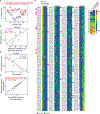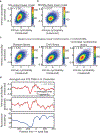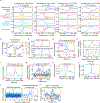Deciphering the mechanical code of the genome and epigenome
- PMID: 36471057
- PMCID: PMC10142808
- DOI: 10.1038/s41594-022-00877-6
Deciphering the mechanical code of the genome and epigenome
Abstract
Diverse DNA-deforming processes are impacted by the local mechanical and structural properties of DNA, which in turn depend on local sequence and epigenetic modifications. Deciphering this mechanical code (that is, this dependence) has been challenging due to the lack of high-throughput experimental methods. Here we present a comprehensive characterization of the mechanical code. Utilizing high-throughput measurements of DNA bendability via loop-seq, we quantitatively established how the occurrence and spatial distribution of dinucleotides, tetranucleotides and methylated CpG impact DNA bendability. We used our measurements to develop a physical model for the sequence and methylation dependence of DNA bendability. We validated the model by performing loop-seq on mouse genomic sequences around transcription start sites and CTCF-binding sites. We applied our model to test the predictions of all-atom molecular dynamics simulations and to demonstrate that sequence and epigenetic modifications can mechanically encode regulatory information in diverse contexts.
© 2022. The Author(s), under exclusive licence to Springer Nature America, Inc.
Conflict of interest statement
Competing Interests:
The authors declare no competing interests.
Figures




Similar articles
-
Links between DNA methylation and nucleosome occupancy in the human genome.Epigenetics Chromatin. 2017 Apr 11;10:18. doi: 10.1186/s13072-017-0125-5. eCollection 2017. Epigenetics Chromatin. 2017. PMID: 28413449 Free PMC article.
-
CpG island mapping by epigenome prediction.PLoS Comput Biol. 2007 Jun;3(6):e110. doi: 10.1371/journal.pcbi.0030110. Epub 2007 May 2. PLoS Comput Biol. 2007. PMID: 17559301 Free PMC article.
-
Linking the epigenome to the genome: correlation of different features to DNA methylation of CpG islands.PLoS One. 2012;7(4):e35327. doi: 10.1371/journal.pone.0035327. Epub 2012 Apr 30. PLoS One. 2012. PMID: 22558141 Free PMC article.
-
Functions of DNA methylation: islands, start sites, gene bodies and beyond.Nat Rev Genet. 2012 May 29;13(7):484-92. doi: 10.1038/nrg3230. Nat Rev Genet. 2012. PMID: 22641018 Review.
-
DNA methylation profiling using the methylated-CpG island recovery assay (MIRA).Methods. 2010 Nov;52(3):213-7. doi: 10.1016/j.ymeth.2010.03.004. Epub 2010 Mar 19. Methods. 2010. PMID: 20304072 Free PMC article. Review.
Cited by
-
Profound Non-Randomness in Dinucleotide Arrangements within Ultra-Conserved Non-Coding Elements and the Human Genome.Biology (Basel). 2023 Aug 12;12(8):1125. doi: 10.3390/biology12081125. Biology (Basel). 2023. PMID: 37627009 Free PMC article.
-
Deciphering the dynamic code: DNA recognition by transcription factors in the ever-changing genome.Transcription. 2024 Jun-Oct;15(3-5):114-138. doi: 10.1080/21541264.2024.2379161. Epub 2024 Jul 20. Transcription. 2024. PMID: 39033307 Free PMC article. Review.
-
Predictions of DNA mechanical properties at a genomic scale reveal potentially new functional roles of DNA flexibility.NAR Genom Bioinform. 2023 Nov 6;5(4):lqad097. doi: 10.1093/nargab/lqad097. eCollection 2023 Dec. NAR Genom Bioinform. 2023. PMID: 37954573 Free PMC article.
-
Molecular Characterization and Genome Mechanical Features of Two Newly Isolated Polyvalent Bacteriophages Infecting Pseudomonas syringae pv. garcae.Genes (Basel). 2024 Jan 18;15(1):113. doi: 10.3390/genes15010113. Genes (Basel). 2024. PMID: 38255005 Free PMC article.
-
FRET-guided modeling of nucleic acids.Nucleic Acids Res. 2024 Jul 22;52(13):e59. doi: 10.1093/nar/gkae496. Nucleic Acids Res. 2024. PMID: 38869063 Free PMC article.
References
-
- Rohs R, Sklenar H & Shakked Z Structural and energetic origins of sequence-specific DNA bending: Monte Carlo simulations of papillomavirus E2-DNA binding sites. Structure 13, 1499–1509 (2005). - PubMed
Methods only references:
-
- Basu A in Methods in Enzymology Vol. 661 305–326 (Elsevier, 2021). - PubMed
Publication types
MeSH terms
Substances
Grants and funding
LinkOut - more resources
Full Text Sources

